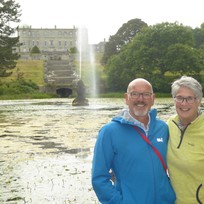( Overview
/ Two Scilly Bullocks on a Boat
Eastbourne’s ‘Diamond Jubilee’ Tamar Class Lifeboat is based in the harbour. Established in 1822 the station took part in the evacuation of the British Expeditionary Force from Dunkirk in 1940.
Finding out times of buses running on a Sunday is nigh on impossible. Arriving at the bus stop, the bus was due half an hour later than we thought, so we decided to walk.
Some of it was on road, but much was cross country. A pretty walk, although the ‘showers’ became insistent rain.
St Mary’s Westham dates from the late 11th century, but alterations were made in the 14th and 18th centuries. Following the death of Queen Elizabeth II on 8th September the bells were rung fully muffled until the day after the state funeral on 19th September 2022, as part of Operation London Bridge.
Walking through the grounds of the castle, we couldn’t find the ticket office, and were becoming more and more soaked.
Very despondent we searched for a cafe. Castle Cottage Tearoom had a sign outside saying they were fully booked, but as we sheltered on their verandah the friendly owner offered to find us a table. A great find, with tasty cheese scones, sandwiches, tea and coffee!
After drying off a little, a castle tour beckoned. A former Roman Saxon Shore fort built circa 290AD, known as Anderitum. Later falling into ruin, it was reoccupied in 1066 by the Normans, and was then continuously occupied until the 16th century; twice starved into surrender, it was never stormed.
First documented in the 13th century, the stone foundations of a small chapel are visible in the inner bailey.
A type of catapult that uses a long arm to throw large projectiles great distances, trebuchets were powerful siege engines until the advent of gunpowder. When excavating, these trebuchet balls were found; witness to a siege suffered by the castle.
In 1066, the beach was just the other side of the walls, but by the 17th century, the castle was over a mile from the sea.
During the Second World War, the castle was garrisoned by the Home Guard, the British and Canadian armies and the United States Army Air Corps.
Machine-gun posts were built, using the Roman and medieval walls as camouflage, in order to control the flat land around Pevensey, and guard against the threat of German invasion.
The dungeon may have served as a store, but was a state prison in the 15th century. Edward, Duke of York (1405), Edmund, Earl of March (1406-09), James I of Scotland (1415) and Joan of Navarre, Dowager Queen of England (1419-20) were also imprisoned in the castle, but probably in better conditions.
On our arrival the Harbour Office only recommended the bar at the Waterfront Restaurants, which is awful. On our return to the marina (another fiasco with buses, but we managed to catch one eventually), we remembered we’d visited the Yacht Club on our previous visit; a warm welcome and Guinness!























 Sign in with Apple
Sign in with Apple  Log in with Facebook
Log in with Facebook